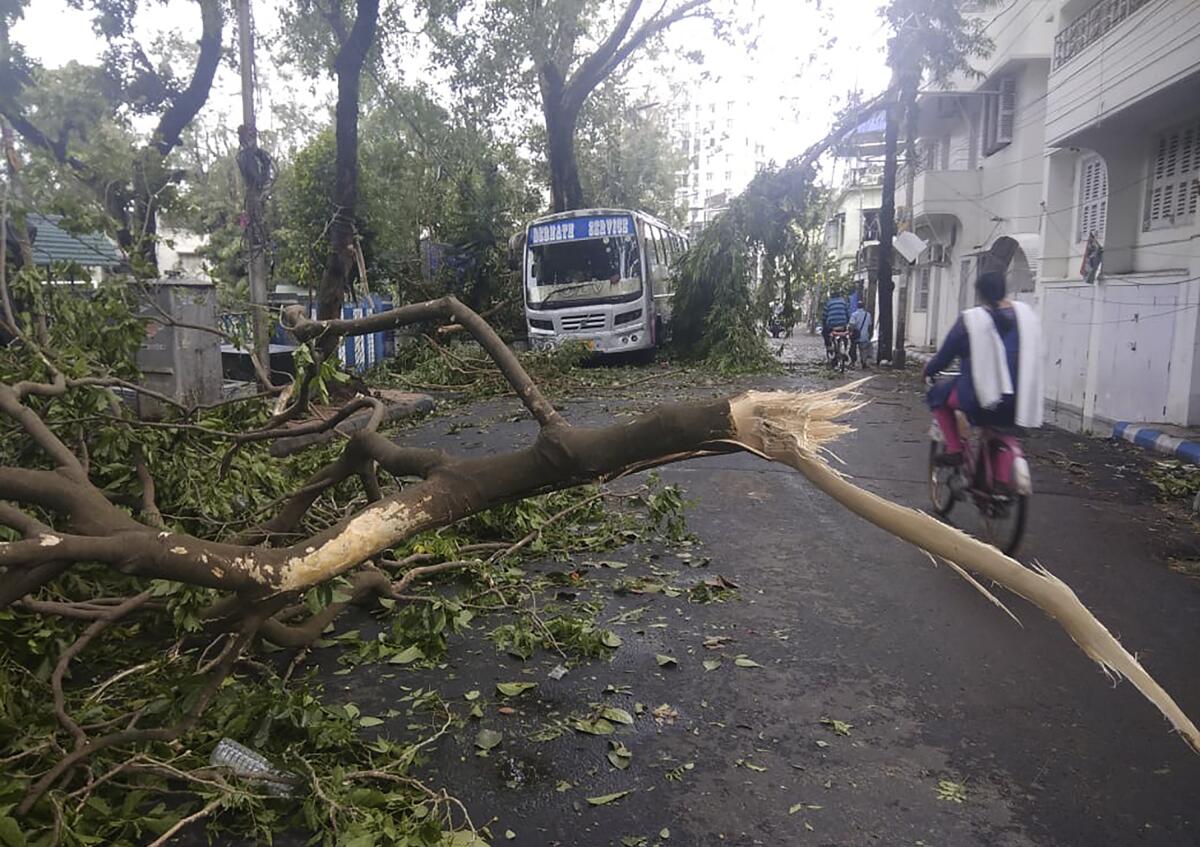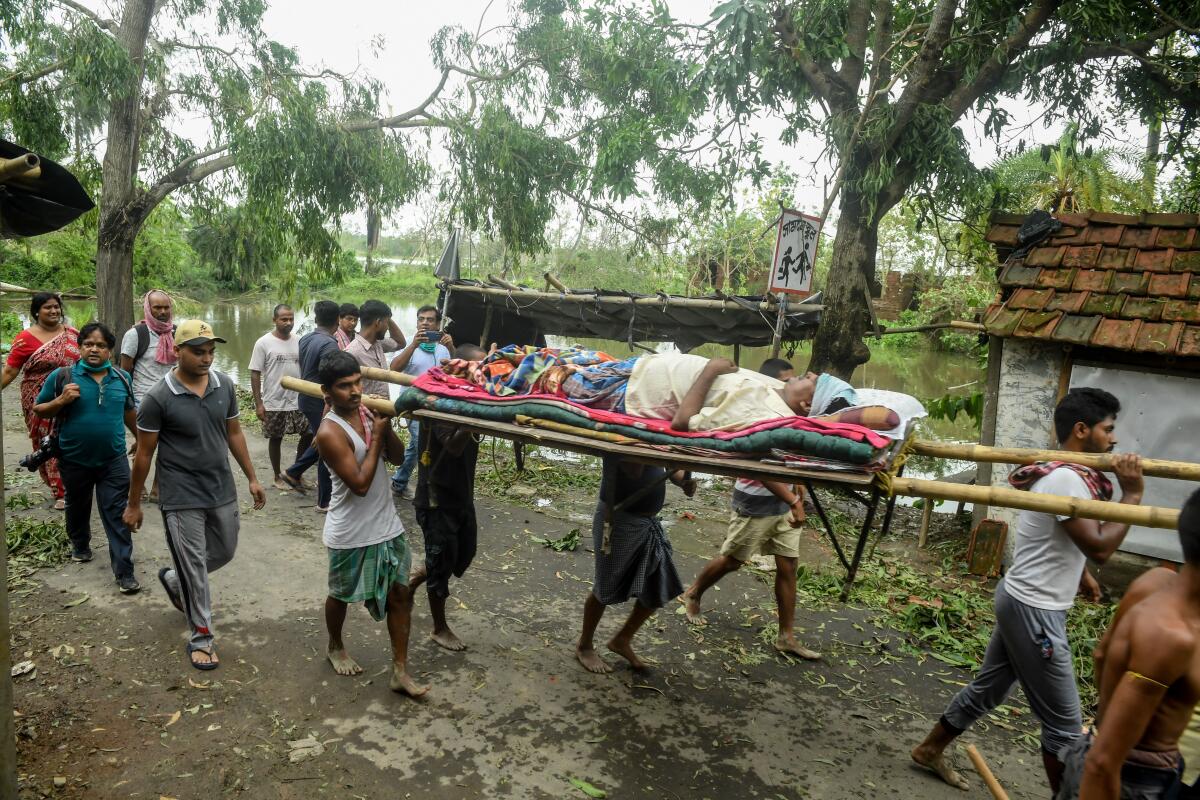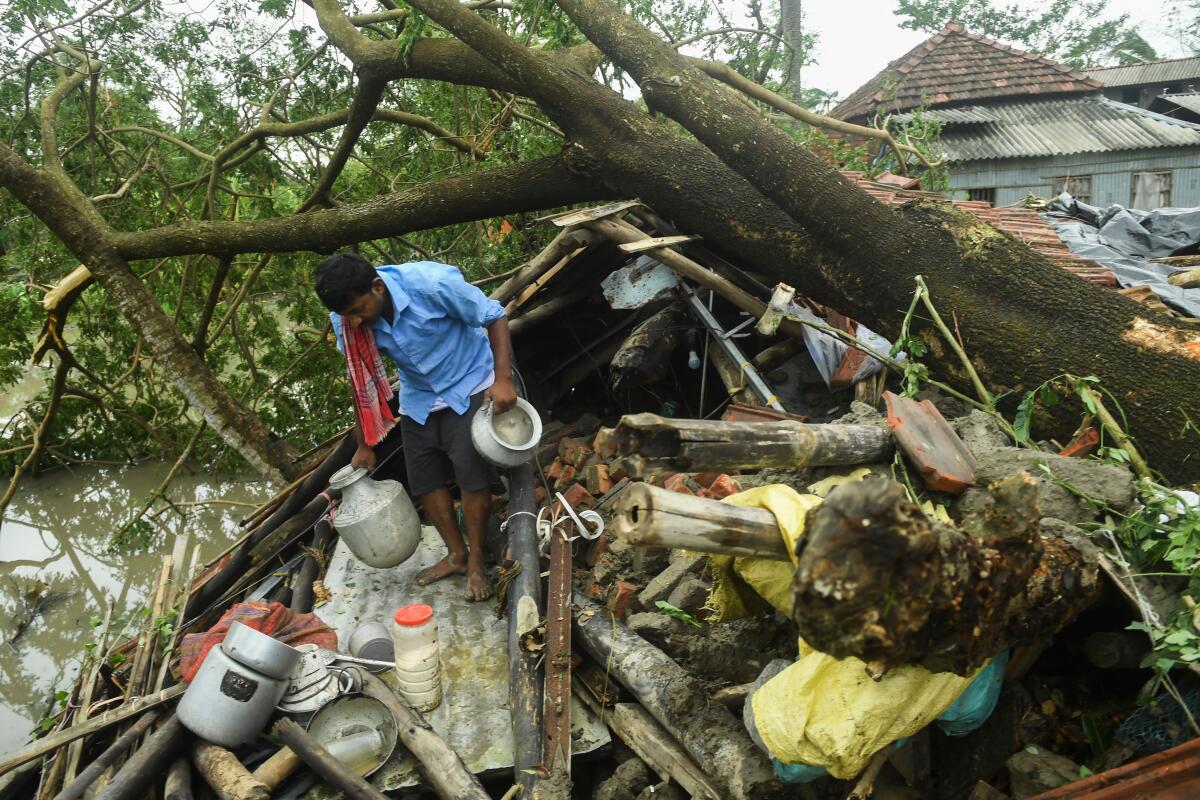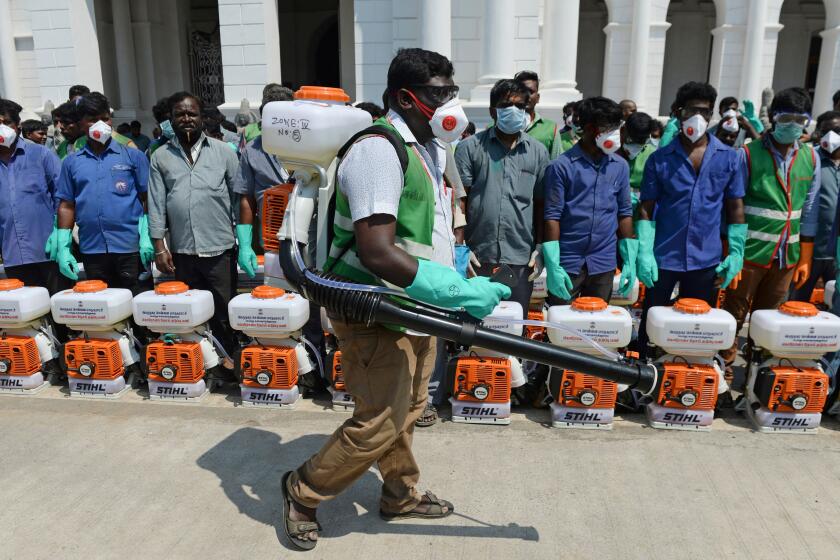At least 80 dead in cyclone in India and Bangladesh

- Share via
NEW DELHI — Wide swaths of coastal India and Bangladesh were flooded and millions were without power Thursday as Cyclone Amphan, the most powerful storm to hit the region in more than a decade, killed over 80 people and cut a path of destruction that is still being assessed.
Many parts of the Indian metropolis of Kolkata, home to more than 14 million people, were underwater, and its airport was closed briefly by flooding. Roads were littered with uprooted trees and lampposts, electricity and communication lines were down and centuries-old buildings were damaged.
Officials in both countries said the full extent of the damage caused by the cyclone was not known because communications to many places were cut. Hundreds of thousands of people were evacuated ahead of the storm, a process complicated by the coronavirus outbreak.
Amphan came ashore Wednesday with heavy rain, a battering storm surge and sustained winds of 105 mph and gusts up to 118 mph. It devastated coastal villages, knocking down mud houses, tearing down utility poles and uprooting trees.
“The roofs of many homes have flown away and the streets are waterlogged,” said Shuli Ghosh, who runs a cafe in Kolkata.
Indian Prime Minister Narendra Modi said authorities were working to get all possible assistance to victims of the cyclone.
“No stone will be left unturned in helping the affected,” he tweeted.

At least 74 people were killed in India, with most of the deaths in West Bengal state, which includes Kolkata. Broadcasters in Bangladesh reported 13 were killed in that country.
More than 1 million people remained without electricity in Bangladesh, where hundreds of villages were flooded.
Shelters were unable to run at full capacity in many places due to the pandemic and some people were too scared of the risk of infection to go there.
The health crisis also will affect relief efforts and the recovery. Damage from the storm is likely to have lasting repercussions for the poor, who are already stretched to the limit by the economic impact of the virus.
In India’s Odisha state, the cyclone destroyed crops of betel, a leaf used as a wrapper for chewing areca nut or tobacco. In Bangladesh’s southwestern district of Bagerhat, more than 500 fish farms were flooded.
Debashish Shyamal, who lives in a fishing village along the West Bengal coast, took shelter with his family in a government clinic. He said the wind blew open the windows and doors and for hours they huddled inside, drenched by the torrential rain.
On Thursday, he discovered dangling electricity wires, waterlogged streets and an uprooted forest.
“There is nothing left,” he said.
The cyclone weakened after slamming ashore Wednesday evening amid massive evacuations. Officials warn that relief and repair work will be made harder by the coronavirus pandemic, which has already sapped the health care system.

In low-lying Bangladesh, up to eight people have died while 12 deaths were reported in West Bengal state in India. Officials said two people died in India’s Odisha state in the Bay of Bengal. Most of the deaths were due to the collapse of walls, drowning and falling trees in both countries.
“We have never seen or heard anything like it. Windows rattled, the house shook, outside trees caught fire while, others collapsed. We thought we would die,” Javed Khan, a taxi driver in Kolkata, told the Associated Press via WhatsApp.
Cyclone Amphan, the equivalent of a Category 3 hurricane, was packing sustained winds of up to 105 mph with maximum gusts of 118 mph when it crashed ashore.
Although it lost power as it moved toward Bangladesh, the densely populated regions of South Bengal bore the brunt of the onslaught with storm surges pushing seawater 15 miles inland and flooding cities including Kolkata.
Experts question India’s coronavirus preparedness in light of its crowds, weak public health system and prevalence of other respiratory illnesses.
The roof of a school building in Howrah, a suburb of Kolkata, flew off in the wind. Numerous coconut trees were struck by lightning and rising rivers overflew their banks.
Heavy rainfall was forecast for many parts of the state in the coming week. The cyclone will disrupt local wind circulation and also trigger heat waves in parts of the country, said India’s meteorological chief, Mrutyunjay Mohapatra.
West Bengal Chief Minister Mamata Banerjee said Wednesday night the damage was difficult to assess immediately. She said that entire islands had been cut off from the mainland, including the communities living along the Sunderbans, one of the largest mangrove forests in the world.
The forests dissipate the energy of the storm and absorb some of the impact, said K.J Ramesh, India’s former meteorological chief.
In the West Bengal state capital of Kolkata, formerly known as Calcutta, many centuries-old buildings were badly damaged, said Banerjee.
Large portions of the metropolis and its suburbs, with a population of 14.1 million, were flooded and many roads littered with uprooted trees, some of which collapsed on parked cars and buildings.
“We are facing three crises: the coronavirus, the thousands of migrants who are returning home and now the cyclone,” she said.
In Bangladesh, at least a million people were without electricity, according to the Ministry of Power.
Hundreds of villages were submerged by a tidal surge across the vast coastal region, disaster-response authorities said. About a dozen flood-protection embankments have been breached, it said.
More to Read
Sign up for Essential California
The most important California stories and recommendations in your inbox every morning.
You may occasionally receive promotional content from the Los Angeles Times.










